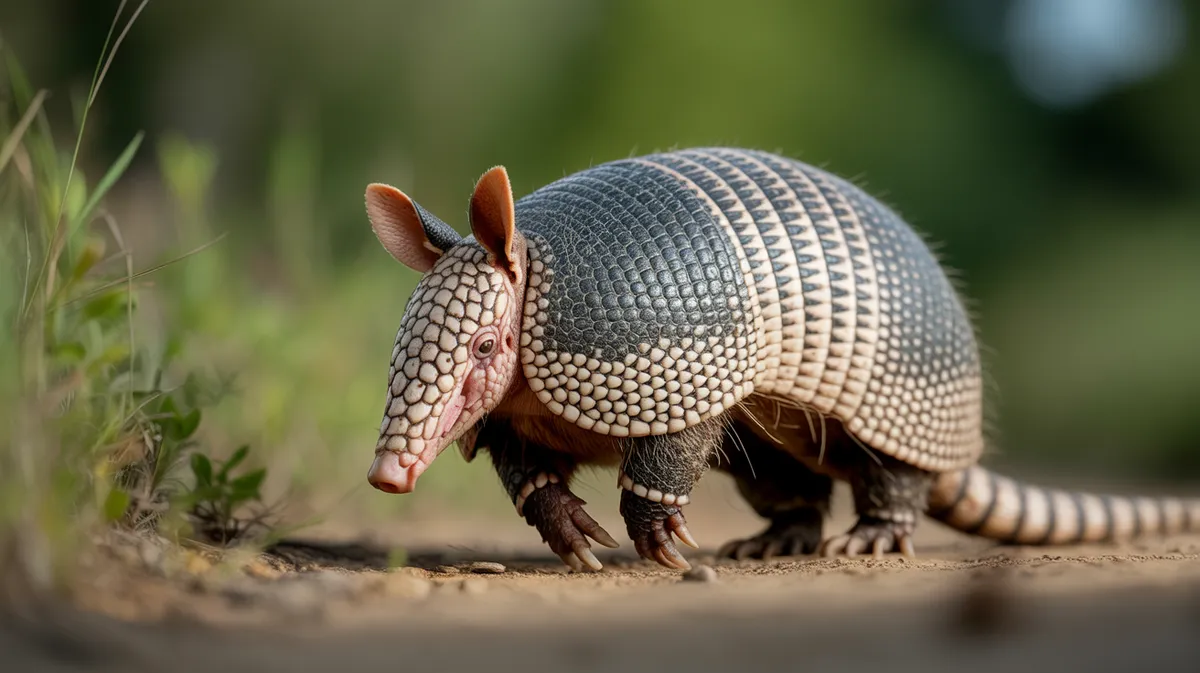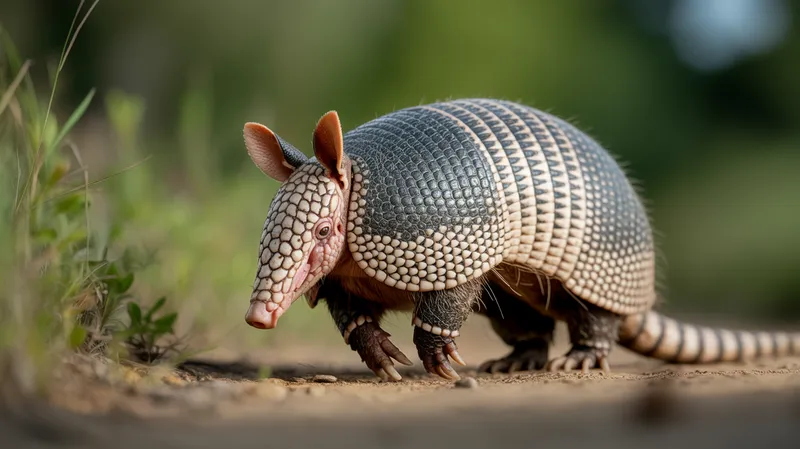
Nine-banded Armadillo
Dasypus novemcinctus

Meet the Nine-banded Armadillo
The Nine-banded Armadillo is a small to medium-sized mammal known for its distinctive armor-like shell made of bony plates. Native to the Americas, it is the only armadillo species found in the United States, ranging from the southern U.S. through Central and South America. This nocturnal animal is adept at digging, using its strong claws to burrow for food and shelter. Armadillos have poor eyesight but compensate with a keen sense of smell, enabling them to locate insects and other invertebrates underground.
Classification
Mammal
Habitat
Grassland, forest, and scrubland
Diet
Omnivore
Lifespan
7-20 years
Conservation
Least Concern
Weight
2.5–6.5 kg
📖Fascinating Facts
Natural Armor
Their protective shell is made from bone and tough skin, providing defense against many predators.
Nocturnal Lifestyle
Nine-banded armadillos are primarily active at night, foraging for insects, grubs, and fruit.
Expert Diggers
They use their strong claws to excavate burrows for shelter and to search for food underground.
📋Detailed Description
The nine-banded armadillo (Dasypus novemcinctus) is a medium-sized, armored mammal measuring 38–58 cm (15–23 in) in body length, with a tail adding 25–53 cm (10–21 in), and typically weighing between 2.5 and 6.5 kg (5.5–14.3 lbs). Its most distinctive feature is the protective carapace, composed of ossified dermal plates covered by tough keratinous scales, arranged in nine flexible, movable bands across the midsection, allowing for surprising agility. The head is elongated with a pointed snout, small eyes, and large, upright ears, while the limbs are short and robust, equipped with strong claws for digging. The species is primarily nocturnal and crepuscular, emerging at dusk to forage. It has poor eyesight but an acute sense of smell, which it uses to locate prey underground. Nine-banded armadillos are solitary for most of the year, occupying overlapping home ranges but rarely interacting outside of the breeding season. Their diet is omnivorous, dominated by insects (especially ants, termites, and beetle larvae), but also includes small vertebrates, eggs, fungi, fruits, and carrion. When threatened, they may leap vertically up to 1 meter (3.3 ft) or dig rapidly to escape predators. The species is highly adaptable, thriving in a range of habitats from grasslands and forests to scrublands and even urban areas, and is notable for its ongoing northward expansion in North America.
💡 Did you know?
The Nine-banded Armadillo is the only mammal other than humans known to regularly contract and carry leprosy.
🔬Research & Sources
Wikipedia Summary
The nine-banded armadillo, also called the nine-banded long-nosed armadillo or common long-nosed armadillo, is a species of armadillo native to North, Central, and South America, making it the most widespread of the armadillos.
Last Modified: 6/5/2025
🎭Behavior & Social Structure
Nine-banded armadillos are primarily solitary and territorial, with individuals maintaining home ranges of 4–13 hectares (10–32 acres), depending on habitat quality. They are most active during twilight and nighttime hours, spending daytime in self-excavated burrows that can be up to 5 meters (16 ft) long and 1.5 meters (5 ft) deep. Foraging involves slow, methodical movement with the snout close to the ground, sniffing for insects and invertebrates. They use their powerful foreclaws to dig for food and to create burrows for shelter and protection. Armadillos are generally silent but may emit low grunts or squeaks when threatened. Social interactions are limited, mostly occurring during the breeding season or when multiple individuals exploit abundant food sources. They are known to be opportunistic feeders, occasionally consuming vertebrate prey or scavenging carrion. Armadillos are also proficient swimmers, able to cross streams by either paddling or inflating their intestines to increase buoyancy.
👶Reproduction & Life Cycle
Breeding typically occurs in summer (July–August in North America), with a unique reproductive adaptation known as delayed implantation: fertilized eggs remain dormant for several months before developing. Gestation lasts about 120 days, but due to delayed implantation, young are born in early spring (March–April). Remarkably, nine-banded armadillos always give birth to genetically identical quadruplets, as a single fertilized egg splits into four embryos—a phenomenon called polyembryony. Newborns are born with soft, leathery skin that hardens within a few weeks. The young remain in the burrow for 2–3 weeks, nursing from their mother, and are weaned by two to three months of age. Sexual maturity is reached at about one year. Parental care is provided solely by the mother; males play no role in rearing offspring.
🛡️Adaptations & Survival
The nine-banded armadillo's most prominent adaptation is its bony carapace, providing effective defense against predators. The flexible bands allow the animal to curl partially, though not completely into a ball like some other armadillo species. Its strong forelimbs and claws are specialized for digging both burrows and foraging for subterranean prey. The species' low metabolic rate and ability to tolerate a wide range of temperatures enable it to survive in diverse environments. Armadillos can hold their breath for up to six minutes, facilitating underwater foraging or crossing water bodies. Their acute olfactory sense compensates for poor vision, and their reproductive strategy of producing identical quadruplets maximizes reproductive output from a single successful mating.
📚Research Sources
🎨Cultural Significance
The nine-banded armadillo holds various roles in human culture. In the southern United States, it is sometimes called the 'Texas state small mammal' and has become a regional symbol. Folklore and popular culture often depict armadillos as quirky or resilient creatures. In some Latin American countries, armadillos have been hunted for food, and their shells used for making musical instruments like the charango. Their association with leprosy has contributed to local myths and cautionary tales. The animal’s unique reproductive biology and armored appearance have also made it a subject of scientific curiosity and educational outreach.
🔬Recent Research & Discoveries
Recent research has focused on the armadillo’s role as a model organism for studying leprosy due to its susceptibility to Mycobacterium leprae, which cannot be cultured in vitro. Studies have also examined the species’ rapid range expansion in North America, investigating ecological impacts and genetic diversity across populations. Ongoing research explores the biomechanics of the armadillo’s armor and burrowing behavior, as well as the evolutionary origins of polyembryony. Conservation studies monitor the effects of road mortality and urbanization on population dynamics. Additionally, armadillos are increasingly used in studies of mammalian reproduction and developmental biology due to their unique reproductive traits.
🎥Wildlife Videos

Armadillos: Nature's Armoured Miracles (Wildlife Documentary) | Wild America | Real Wild
Named "little armored one" by Spanish Conquistadors, the Armadillo's lizard-like skin and bony-plated shell give it a perfect ...
Real Wild

The nine-banded armadillo
The armor from which their name comes protects them against enemies and allows them to make their way through the ...
New Atlantis WILD

The Nine Banded Long-Nosed Armadillo
This is the common armadillo seen in the southern US and Central America. It can be seen day or night but is most active at night.
James Wolfe

Animal Bytes: The Nine Banded Armadillo
Armadillos are like little buldozers....scrounging around for insects and berries and digging burrows up to 25 feet long!
Odyssey Earth

Armadillo a Bulletproof creature of animal kingdom ! Wildlife Documentary
... skuts vary among different armadillo species for instance the nine-banded armadillo one of the most common species has nine ...
TheWildlifeScience

5 Fun Facts About The Nine-Banded Armadillo
Music: Alive Musician: @iksonmusic.
Your5Facts
🌍Habitat Information
The Nine-banded Armadillo typically inhabits Grassland, forest, and scrubland environments. Nine-banded Armadillos have adapted to their environments with specialized features and behaviors.
Primary Habitat:
Grassland, forest, and scrubland
More detailed habitat information will be available soon.
🛡️Conservation Status
The Nine-banded Armadillo is currently classified as Least Concern. Conservation efforts are crucial for preserving this species for future generations.
Common Threats:
- 🏠Habitat loss and fragmentation
- 🌡️Climate change impacts
- 🎯Hunting and poaching
- 🏭Human-wildlife conflict
⚠️Threats & Conservation Challenges
Currently classified as Least Concern by the IUCN, the nine-banded armadillo faces few significant natural threats due to its adaptability and reproductive success. Predators include coyotes, bobcats, cougars, alligators, and large birds of prey, as well as domestic dogs. Human-related threats include road mortality (a major cause of death in the United States), habitat fragmentation, and, in some regions, hunting for meat or traditional medicine. The species is also a known reservoir for Mycobacterium leprae, the bacterium causing leprosy, which has led to some public health concerns. Despite these challenges, populations are stable or expanding, particularly in the United States, where the species continues to move northward due to climate change and lack of natural barriers.
🔬Scientific Classification
Scientific Name
Dasypus novemcinctus
Classification Hierarchy
🔍 About Taxonomic Classification
Taxonomic classification is a hierarchical system used by scientists to classify and organize living organisms based on shared characteristics and evolutionary relationships.
The system moves from broad categories (Kingdom) to increasingly specific ones, with each animal's scientific name typically consisting of its Genus and species.
📝Community Notes
Share your observations and insights about the Nine-banded Armadillo with our community of wildlife enthusiasts.
Join Our Community
Sign in to share your observations and connect with fellow wildlife enthusiasts.
Sign In to ContributeNo community notes yet
Be the first to share your observations about the Nine-banded Armadillo!
Explore Nine-banded Armadillo
Select a tab above to learn more about this amazing animal.
📸Photo Gallery
No photos available for this animal yet.
🌟Discover More Wildlife
Continue your journey of discovery with more fascinating animals from our database
